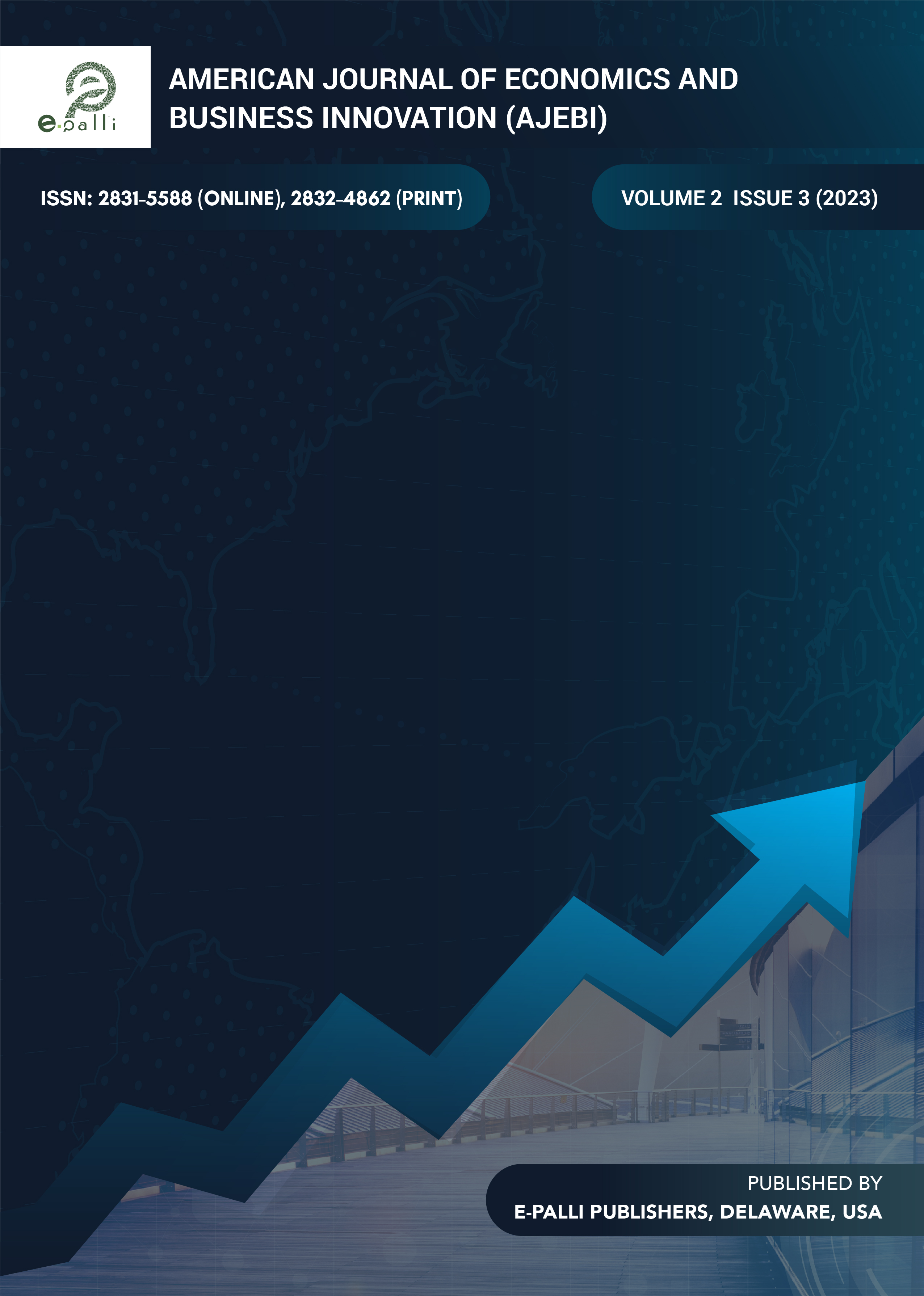Testing an Adapted Technology Acceptance Model (TAM) for Factors Influencing E-Commerce Adoption - A Lesotho Consumers’ Perspective
DOI:
https://doi.org/10.54536/ajebi.v2i3.2104Keywords:
E-Commerce Adoption, E-Commerce, Lesotho, Technology Acceptance Model (TAM)Abstract
The purpose of this study is to investigate the factors that influence E-Commerce adoption from a Lesotho consumers’ perspective and further classify these under a cluster of either enabling or inhibiting factors of the technology in the context of study using an adapted Technology Acceptance Model (TAM) as a framework. TAM has been widely used to understand why some individuals embrace technology, while others reject the same. However, several studies have identified TAM’s inability to predict a purchase intention; hence the study proposed to test a conceptual framework adapted from (TAM) with the relevant constructs that influence E-Commerce adoption as identified by literature to compensate for the weaknesses. The investigation employed a quantitative research approach, and a survey was distributed online to collect data. 275 participants responded to the survey. Both snowball and purposive sampling techniques were used, and data was analysed using Confirmatory Factor Analysis (CFA). The research findings revealed: Attitude and Convenience, Time and Cost Savings, and Perceived Ease of Use as enabling factors, whereas Dependability, and Accessibility and Policy Initiatives were established as inhibiting factors in Lesotho. Meanwhile, descriptive statistics established that 74.6% of consumers have adopted the technology. Ultimately, a new conceptual framework was developed from the constructs that are unique to Lesotho and it was coined Mokhoro – Which is a Basotho rondavel or hut.
Downloads
References
Administration, I. T. (2021). Lesotho - Country Commercial Guide. Retrieved from https://www.trade.gov/country-commercial-guides/lesotho-ecommerce.
Ajibade, P. (2018). Technology Acceptance Model Limitations and Criticisms: Exploring the Practical Applications and Use in Technology-related Studies, Mixed-method, and Qualitative Researches. Library Philosophy and Practice (LPP), 1-13.
Ajzen, I. (1991). The Theory of Planned Behaviour. Organizational Behavior and Human Decision Processes, 180-209.
Akelloh, C. O., Raburu, G., Liyala, S. & Onditi, L. A. (2017) . Infrastructure A Major Barrier to Ecommerce Development and. Journal of Information Engineering and Applications , 7(9), 17-27.
Alam, S. S., Khatibi, A. A., Ismail, H. B. & Ahmad, I. (2005). Perceived Benefits of E-Commerce Adoption in the Electronic Manufacturing Companies in Malaysia. Journal of Social Sciences, 1(3), 188-193.
Aleid, F. A. A. (2011). An Investigation of the Factors Affecting Consumers’ Adoption of E-commerce: An Empirical Study of Saudi Arabia. Leicester: Semanticscholar.
Alistair, T. (2022). The Digital Economy and Ecommerce, Johannesburg: South African Institute of International Affairs (SAIIA).
Allmen, R. S. V. et al. (2019). Randomized controlled comparison of cross sectional survey approaches to optimize follow-up completeness in clinical studies. Plos One, 1-13.
Al-Mamary, Y. H., Al-nashmi, M., Hassan, Y. A. G. & Shamsuddin, A. (2016). A Critical Review of Models and Theories in Field of Individual Acceptance of Technology. International Journal of Hybrid Information Technology, 9(6), 143- 148.
Almousa, M. (2013). Barriers to E-Commerce Adoption: Consumer’s Perspectives From a Developing Country. iBusiness, 67-71.
Alqahtani, M. A., Al-Badi, A. H. & Mayhew, P. J. (2014). Exploratory Study of M-Transaction: User’s Perspectives. The Electronic Journal on Information Systems in Developing Countries, 60(7), 1-22
Alsmadi, I. & Alhami, I. (2009). The Requirements for Building an E-commerce Infrastructure. ResearchGate, 1-9.
Anas, A. et al. (2021). An Overview of Research on E-Commerce Adoption: Future Trends. Journal of Management Information and Decision Sciences, 24(1), 1-10.
Bakos, Y. (2001). The Emerging Landscape for Retail. Journal of Economic Perspectives, 15(1), 69-80.
Basarir-Ozel, B. & Mardikyan, S. (2017). Factors affecting E-commerce adoption: A case of Turkey. The International Journal of Management Science and Information Technology, 1(23), 1-11.
Budyastuti, T. & Iskandar, D. (2018). The Influence of Usefulness, Easy of Use and Trust Using E-Commerce To User Behaviour (Case Study To Lazada.Com Consumers). Journal of Marketing and Consumer Research , 46, 78-83.
BusinessTeam. (2021). Online selling platforms & marketplaces in Lesotho. Retrieved fromhttps://www.usabusiness.co.in/online-selling-platforms-marketplaces-lesotho
Chan, B. & Al-Hawamder, S. (2002). The development of e-commerce in Singapore: The impact of government initiatives. Business Process Management Journal, 8(3), 278-288.
Chandratre, P. & Kulkarni, U. (2014). Implementation of Trust Issues in Ecommerce. International Journal on Recent and Innovation Trends in Computing and Communication, 2(9), 2898-2902.
Chan, L. L. & Idris, N. (2017). Validity and Reliability of The Instrument Using Exploratory Factor Analysis and Cronbach’s alpha. International Journal of Academic Research in Business and Social Sciences, 7(10), 400-410.
Christian, M. K. & Asa, R. S. (2015). Factors Influencing e-commerce development: Implications for the developing countries. International Journal of Innovation and Economic Development, 1(1), 64-72.
Combe, C. (2006). Introduction to E-Business Management and Strategy. (1st ed.) Netherlands: Butterworth-Heinemann-Elsevier.
Creswell, J. W. et al. (2016). First Steps in Research. (2nd ed.) Pretoria: Van Schaik Publishers.
Datta, P. (2011). A preliminary study of e-commerce adoption in developing countries. Information Systems Journal, 3-32.
Davis, F. D., Bogozzi, R. P. & Warhaw, P. R. (1989). User Acceptance of Computer Technology: A Comparison of Two Theoritical Models. Management Science, 35(8), 982-1003.
De-Vos, A., Strydom, H., Fouche, C. B. & Delport, C. S. L. (2011). Research at Grass Roots: For Social Sciences and Human Service Professions. (4th ed.) Pretoria: Van Schaik Publishers.
Ekekwe, N. (2015). The Challenges Facing E-Commerce Start-ups in Africa. Retrieved from https://hbr.org/2015/03/the-challenges-facing-e-commerce-start-ups-in-africa
Expert, C. (2020). Convenience is Driving E-commerce Growth and Influencing Consumer Decisions. retrieved from https://www.smartinsights.com/ecommerce/customer-experience- examples/convenience-is-driving-e-commerce-growth-and-influencing-consumer-decisions
Farhang, S., Abdollahbeigi, B. & Langroudi, A. C. (2012). The Impact of Website Information Convenience on E-commerce Success of Companies. Cyberjaya, ELESEVIER.
Fayada, R. & Paper, D. (2015). The Technology Acceptance Model E-Commerce Extension: A Conceptual Framework. Logan, ELSEVIER.
Ferrette, C. P. (2000). E-Commerce and International Political Economics: The Legal and Political Ramifications of the Internet on World Economies. ILSA Journal of International and Comparative Law, 7(1), 16-37.
Franco, E. C. & Regi, B. S. (2016). Advantages and Challenges of E-Commerce Customers and Businesses: In Indian Perspective. International Journal of Research -GRANTHAALAYAH, 4(3), 7-13.
Galant, V., Jakubczyc, J. & Paprzycki, M. (2002). Infrastructure For E-commerce. Oklahoma, Researchgate.
Garg, A. K. & Choeu, T. (2015). The Adoption of E-Commerce by Small and Medium Enterprises in Pretoria East. The Electronic Journal of Information Systems in Developing Countries, 68(7), 1-23.
Garg, A. k. & Choeu, T. (2015). The Adoption of Electronic Cpmmerce by Small and Medium Enterprises in Pretoria East. The Electronic Journal of Information Systems in Developing Countries, 68(7), 1-23.
Gary, H. (2019). 15 Must-Have Features for Ecommerce Sites. retrieved from https://www.searchenginejournal.com/ecommerce-guide/must-have-website- features/#close
Gibbs, J., Kraemer, K. L. & Dedrick, J. (2002). Enviroment and Policy Factors Shaping E-Commerce Diffusion: A Cross-Country Comparison, Irvine: Center for Research on Information Technology and Organization.
GlobalData. (2019). Ecommerce Landscape in Asia-Pacific: Drivers, Market Players, and Telcos’ Role. retrieved from https://www.researchandmarkets.com/reports
Goga, S. (2021). E-commerce in a postCovid-19 era: Building on industry gains, Johannesburg: Centre for Competition, Regulation and Economic Development.
Hochmuth, P. (2009). Trust Marks: What’s Behind the Label Counts, Boston: Yankee Group Research, Inc.
Hurley, J. & M, Z. (2021). Finding Time and Cost Savings in International E-Commerce. retrieved from https://www.livingstonintl.com/finding-time-and-cost-savings-in-international-e-commerce
ITC. (2015). The International E-Commerce in Africa: The Way Forward, Geneva: ITC.
Kabango, C. M. & Asa, A. R. (2015). Factors influencing e-commerce development: Implications for the developing countries. International Journal of Innovation and Economic Development ,1(1), 64-72.
Karim, M. W., Chowdhury, M. A., & Haque, A. K. (2022). Study of Customer Satisfaction Towards E-Wallet Payment System in Bangladesh. American Journal of Economics and American Journal of Economics and Innovation, 1-10. 1(1) https://doi.org/10.54536/ajebi.v1i1.144
kibuacha, F. (2021). E-Commerce in South Africa: The Growth, and the Future.retrieved from https://www.geopoll.com/blog/e-commerce-south-africa
Kosasi, S., Vedyanto, Kasma, U. & Susilo, B. (2019). The Mediating Role of Intention to Use. s.l., ResearchGate.
Kothari, C. R.(2004). Research Methodology: Methods and Techniques. 2nd ed. New Delhi: New Age International Publishers.
Kurnia, S. (2007). E-Commerce Adoption in Developing Coutries: an Indonesian Study. retrieved from https://www.academia.edu/29486954/E- Commerce_Adoption_in_Developing_Countries_an_Indonesian_Study
Lai, P. C. (2017). The Literature Review of Technology Adoption Models. Journal of Information Systems and Technology Management, 14(1), 21-38.
Lai, P. C. (2017). The Literature Review of Technology Adoption Models and Theories for the Novelty Technology. Journal of Information Systems and Technology Management, 14(1), 21-38.
Larsen, R. & Warne, R. (2010). Estimating confidence intervals for eigenvalue in sexploratory factor analysis. psychonomic-journals, 42(3), 871-876.
Lee, S., Ahn, C., Song, M. K. & Ahn, H. (2018). Trust and Distrust in E-Commerce. Reasearchgate, 1-19.
Leibowitz, B. (2020). Five Ways for Ecommerce Websites to Build Trust. retrieved from https://www.neurosciencemarketing.com/blog/articles/ecommerce-trust.htm
Leong, M. K. & Chaichi, K. (2021). The Adoption of Technology Acceptance Model (TAM) and Trust in Influencing Online Purchase Intention During the Covid-19 Pandemic: Empirical Evidence from Malaysia. International Journal of Academic Research in Business and Social Sciences,11(8), 468-478.
Lianos, I. & Botwright, K. (2019). Five Ways to Increase Trust in E-commerce. retrieved from https://www.weforum.org/agenda/2019/03/five-ways-to-restore-trust-in-e-commerce
Lianos, l. (2019). Five ways to increase trust in e-commerce. retrieved from https://www.weforum.org/agenda/2019/03/five-ways-to-restore-trust-in-e-commerce
Lou, T. & Li, E. (2017). Integrating Innovation Diffusion Theory and the Technology Acceptance Model: The adoption of blockchain technology from business managers’ perspective. Dubai, The 17th International Conference on Electronic Business.
Macovei, O. (2015). Applying the Theory of Planned Behavior in Predicting Pro- environmental. ResearchGate, 11(4), 17-32.
Makame, W. H., Kang, J. & Park, S. (2014). Factors influencing electronic commerce adoption in developing countries: The case of Tanzania. South African Journal of Business Management , 45(2), 83-96.
Malawer, S. S. (2001). Global Governance of E-commerce and Internet Trade: Recent Developments. World Trade Law, 14-19.
Manoj, S. & Amar, K. (2007). Theory of Reasoned Behaviour & amp; Theory of Planned Behaviour in Alcohol and Drug Education. Journal of Alcohol and Drug Education, 3-5.
Matbouli, H. & Gao, Q. (2012). An overview on web security threats and impact to e-commerce success. Sousse, 2012 International Conference on Information Technology and e-Services.
Mwencha, et al. (2014). Security, Privacy & Trust Issues Sorrounding E-Commerce in Kenya. Nairobi, 15th Strathmore University Annual ICT Conference.li
Nagra, G. & Gopal, R. (2013). An study of Factors Affecting on Online Shopping. International Journal of Scientific and Research Publications, 3(6), 1-4.
Ochara, N. M., Kadyamatimba, A., Lehloa, P. & Sotnikov, A. (2019). The Influence of National Information Ecology on e-Commerce Adoption in Developing Countries. Moscow, XXII International Conference Enterprise Engineering and Knowledge, 1-14.
Papazafeiropoulou, A. & Pouloudi, A.(2000). The Government’s Role in Improving Electronic Commerce Adoption. Vienna, ResearchGate.
Petty, R. E., Laxer, R. M., Lindsley, C. B. & Wedderburn, L. (2016). Textbook of Pediatric Rheumatology. (7th ed.) Philadelphia: Saunders.
Rahayu, R. & Day, J. (2017). E-commerce adoption by SMEs in developing countries: evidence from Indonesia. Eurasian Business Review, 7, 25-41.
Renman, S. U. & Alam, R. (2016). A Study of Barriers to E-Commerce Adoption among SMEs in Malaysia. University of Modern Sciences, 1(1), 45-58.
Rigopoulos, G., Psarras, J. & Askounis, D. T. (2008). A TAM Model to Evaluate User’s Attitude Towards Adoption of Decision Support Systems. Journal of Applied Sciences, 8(5), 899-902.
Rouse, M. (2019). e-commerce (electronic commerce or EC). retrieved from https://searchcio.techtarget.com/definition/e-commerce [Accessed 1 May 2019].
Salehi, F., Abdollahbeigi, B., Langroudi, A. C. & Salehic, F. (2012). The Impact of Website Information Convenience On E-commerce Success of Companies. Procedia- Social and Behavioral Sciences, 381-387.
Senneville, J. P. (2021). Consumers won’t give up the convenience of e-commerce after the pandemic is over. retrieved from https://www.bdc.ca/en/articles-tools/blog/consumers-wont-give-up-convenience-e-commerce-after-pandemic-over
Shia, B., Chen, M., Ramdansyah, A. & Wang, S. (2015). Comparison of Decision Making in Adopting E- Commerce between Indonesia and Chinese Taipei (Case Study in Jakarta and Taipei City. American Journal of Industrial and Business Management, 5, 748-768.
Singhal, R., Mittal, R. & Agarwal, S. (2019). Development of E-Commerce in Developing Countries (I.T. - Management ). International Journal of Management and Business, 4, 1-8.
Skidmore, S. & Lee, M. (2022). What is Non-Experimental Research?.retrieved from https://study.com/learn/lesson/non-experimental-vs-experimental-research-design-methods-examples.html
Stats, I. W. (2019). Internet World Stats, Usage and Popuation Statistics. retrieved from https://www.internetworldstats.com/emarketing.html
Thesele, M. (2019). Cyber Security Bill Proposed [Interview] (14 March 2019).
Tigre, P. B. & O’Connor, D. (2002). Policies and Institutions For E-Commerce Readiness: What Can Developing Countries Learn From OECD?. retrieved from https://www.oecd- ilibrary.org
tímù, Y. z. s. l. z. q. y. z. & yīngwén, Y. s. z. q. y. (2010). The Importance of e-Convenience in Modern Day e-Commerce. retrieved from http://thesis.topco global.com/TopcoTRC/2010_Thesis/G0014.pdf
UNCTAD. (2019). Lesotho Rapid eTrade Readiness Assessment, Geneva: United Nations Conference on Trade and Development.
UNDP. (2020). Surviving the lockdown: the new normal experience. retrieved from https://www.undp.org/lesotho/blog/surviving-lockdown-new-normal-experience
Vaicondam, Y., Subramaniam, M. & Aliyu, M. (2020). Hypermarkets‟E-commerce Adoption among Youth in Puchong, Malaysia. International Journal of Psychosocial Rehabilitation, 24(01), 766-773.
Varghese, J. (2020). Ecommerce Security: Importance, Issues and Protection Measures. retrieved from https://www.getastra.com/blog/knowledge-base/ecommerce-security
Vaughan-Nichols, S. J. (2018). It’s HTTPS or bust: How to secure your website. retrieved from https://www.zdnet.com/article/how-to-secure-your-website
Vinculum. (2020). What Is an eCommerce Enabler?. retrieved from https://www.vinculumgroup.com/what-is-ecommerce-enabler
Waseem, A. et al. (2019). Factors Affecting E-commerce Potential of Any Country Using Multiple Regression Analysis. Journal of Internet Banking and Commerce, 24(2), 1-28.
Wasfi, A., Al-zawahreh, A. & Zeglat, D. (2012). The Importance of Trust and Security Issues in E-Commerce Adoption in Arab World. European Journal of Economics and Administrative Sciences, 1(52), 172-178.
Watanabe, G. (2017). Anatomy of a Secure URL. retrieved from https://frontntweaks.com/2017/09/14/anatomy-of-a-secure-url
Winchester, A. (2019). Five Trust Badges that can Increase your Conversion Rate. retrieved from https://www.oberlo.com/blog/trust-badges
Yaghi, M. (2017). The benefits, opportunities and barriers of ecommerce for a developing country. International Journal of Scientific & Engineering Research, 8(1), 1841- 1842.
Downloads
Published
How to Cite
Issue
Section
License
Copyright (c) 2023 Molelekeng Jeanett Kobane

This work is licensed under a Creative Commons Attribution 4.0 International License.













